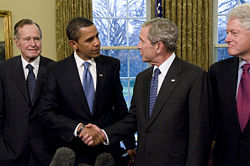Ideograph
From DigitalRhetoricCollaborative
An ideograph is a word or phrase with a vague definition which represents an ambiguous set of ideas. This causes ideographs to be able to be used without sending a particular message because people can be affected in several ways by the way the ideograph is used or by their own interpretation of it. The term was first used by Michael Calvin McGee in 1980 to describe certain words used in political discourse.[1] While they are not limited to politics, some of the more commonly used ideographs are frequently used in political discourse. Terms such as 'liberty', 'freedom', and 'equality' all refer to an ideology, but to no specific referent. This allows ideographs to persuade without necessarily having a significant purpose or meaning.
Contents |
Introduction
[2] After the attacks on September 11, 2001, President George Bush, and later President Barack Obama, frequently used this term to invoke in citizens the same sense of fear that was felt during the attacks.Artifact Analysis
Terrorism qualifies as an ideograph because it doesn't refer to any one specific subject, just terrorists in general. Terrorism is a particularly important ideograph because not only does it represent an ideology, it also invokes a strong emotional response among audiences. While liberty, freedom, and equality all have fairly positive connotations and invoke a sense of nationalism, terrorism (as it's used by politicians in the United States) has a significantly negative connotation. It reminds people of the fear they felt on 9/11 to promote a more powerful sense of national pride among audiences than liberty, freedom, or equality. It is because of these traits that politicians often use the word to their advantage.
Despite the fact that not all politicians use the ideograph terrorism in the same fashion, they all use it to achieve the same greater goal of uniting the country. For example, Barack Obama used the ideograph terrorism to defend America's 'rule of law' (Also an ideograph: rule of law refers to an idea, not a specific subject.) against foreign attackers who want to affect it. He creates a sense of nationalism, as well as some fear, among audiences by telling them that if terrorism isn't stopped, terrorists will change the United States for the worse.[3]
However, George W Bush, who used the ideograph in the years immediately following 2001, was able to create more fear than nationalism because the memory of 9/11 was fresher in audiences' minds. Bush called for a 'War on Terror' in order to convince audiences that it is the moral obligation of the United States to stop terrorists as to prevent other nations from a similar national tragedy. Although Bush's main use of the ideograph is to fight for morality, he didn’t limit himself to that single topic. Bush also attacked terrorism in the same vain that Obama did by defending American rule of law (“They hate what we see right here in this chamber - a democratically elected government.”)[4] along with defending ethics (“Nor will we forget the citizens of 80 other nations who died with our own: dozens of Pakistanis; more than 130 Israelis; more than 250 citizens of India...”).[5]
Additional Resources
References
- ↑ McGee, Calvin Michael. "The 'ideograph': A link between rhetoric and ideology." Quarterly Journal of Speech 66:1 (1980). 1-16. Print.
- ↑ http://www.zimbio.com/pictures/iVWq26iWCLa/Bush+Hosts+Obama+Former+Presidents+White+House/AIYYLtxH7HC/George+W+Bush Another frequently used ideograph in the 21st century is 'terrorism'. Terrorism is defined as “the use of violent acts to frighten the people in an area as a way of trying to achieve a political goal.”<ref>[http://http://www.merriam-webster.com/dictionary/terrorism http://www.merriam-webster.com/dictionary/terrorism]</li> <li id="cite_note-2">[[#cite_ref-2|↑]] Obama, Barack H. "Remarks by the President on National Security." ''whitehouse'' Office of the Press, 21 May, 2009. Web. 16 April, 2015. [https://www.whitehouse.gov/the_press_office/Remarks-by-the-President-On-National-Security-5-21-09/ https://www.whitehouse.gov/the_press_office/Remarks-by-the-President-On-National-Security-5-21-09/]</li> <li id="cite_note-3">[[#cite_ref-3|↑]] Bush, George W. "President Bush Addresses the Nation." ''washingtonpost''. The Washington Post Company, 20 September, 2001. Web. 16 April, 2015 [http://www.washingtonpost.com/wp-srv/nation/specials/attacked/transcripts/bushaddress_092001.html http://www.washingtonpost.com/wp-srv/nation/specials/attacked/transcripts/bushaddress_092001.html]</li> <li id="cite_note-4">[[#cite_ref-4|↑]] Bush, George W. "President Bush Addresses the Nation." ''washingtonpost''. The Washington Post Company, 20 September, 2001. Web. 16 April, 2015 [http://www.washingtonpost.com/wp-srv/nation/specials/attacked/transcripts/bushaddress_092001.html http://www.washingtonpost.com/wp-srv/nation/specials/attacked/transcripts/bushaddress_092001.html]</li></ol></ref>

